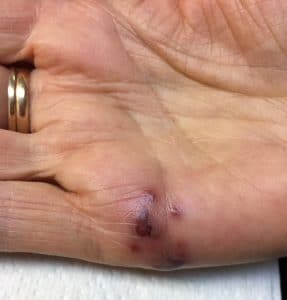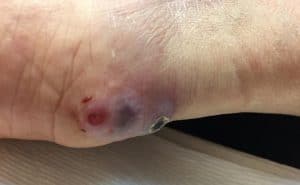Shingles Herpes Zoster

we
Shingles Herpes Zoster
Shingles Herpes Zoster presents as a red rash that often wraps around the torso. However, it may appear anywhere on the body. A headache with fever and fatigue frequently accompanies it.
There are two shingles vaccines approved in the United States:
- Zostavax (zoster vaccine live) is a injection that can prevent shingles in adults 60 years or older.
- Shingrix (herpes zoster subunit vaccine) is a vaccine used on adults 50 years or older. This vaccine is given in two doses. The second dose is given between 2 and 6 months after the first. It is the best option due to its high success (>90% effectiveness).
Shingles is a product of the virus that causes chickenpox, the varicella-zoster virus. Regardless of when the disease was contracted, anyone who has had chickenpox is at risk for shingles later down the line.
Those with impaired immune systems, such as the elderly, and while it can be painful, there are early treatment options to lessen symptom development like antivirals such as Valtrex.
Shingles (herpes zoster)
What is shingles?
Shingles Herpes Zoster is a type of rash that results from a viral infection; the same virus that causes chickenpox, the varicella (chickenpox) zoster (shingles) virus. This type of rash can be very painful, and symptoms can last for months after being cured.
What causes Shingles Herpes Zoster?

The only way to get shingles is a past infection of chickenpox. Only about 20% of infected people will ever get shingles in their lifetime.
There is no real reason why the virus could become active again. Although there are factors that can increase the likelihood of its occurrence:
- The elderly are more at risk for shingles Shingles Herpes Zoster.
- Physical and emotional stress can provoke a reaction.
- A weakened immune system due to an illness such as HIV infection, leukemia, or lymphoma.
- Any kind of treatments that suppress the immune system, such as radiotherapy for cancer, chemotherapy, steroids, and any medications used to prevent organ rejection.
Is Shingles Herpes Zoster contagious?
Shingles cannot be transmitted from someone who has shingles. Rather, it can only occur when a person who has already been infected with the herpes zoster virus experiences a change in their immune systems ability to fight off the virus. However, a person with an active shingles infection can transmit chickenpox to someone that has not had the virus. The virus can be transferred until the blisters crust over, which takes about a week.
Is shingles hereditary?
No.
What are the symptoms of shingles?
Shingles is infamous for the pain it causes. This is the first symptom to typically appear. Not always will pain be present, especially in the young. Rather a mild itching or burning sensation can develop in the affected area.
When pain is present, it usually tends to stay localized. It can be mild to severe. The pain may include a tingling, aching or burning sensation. A rash develops a few days following the onset of pain. A fever and/or headache may follow.
Can someone who has never had chickenpox get shingles?
Shingles is caused by the reactivation of the varicella-zoster virus, which is the same virus that causes chickenpox. If someone has never had chickenpox or the varicella-zoster virus, they cannot develop shingles. Shingles occurs in individuals who have had a previous chickenpox infection, as the virus remains dormant in the body after the initial infection. Therefore, if someone has not been exposed to the varicella-zoster virus through chickenpox or vaccination, they are not at risk of developing shingles.
Can stress trigger a shingles outbreak?
Yes, stress can potentially trigger a shingles outbreak in individuals who have the dormant varicella-zoster virus in their body. Stress weakens the immune system, and a weakened immune system can allow the virus to reactivate and cause shingles. While stress alone may not directly cause shingles, it can be a contributing factor, especially in people who are already at risk due to their previous exposure to the varicella-zoster virus.
It’s important to manage stress through healthy lifestyle choices, relaxation techniques, and seeking support if needed. If you’re concerned about shingles or have experienced symptoms, it’s advisable to consult with a healthcare professional for guidance and appropriate care.
How can someone prevent the spread of shingles to others?
To prevent the spread of shingles to others, individuals should take precautions to minimize the risk of transmitting the varicella-zoster virus. Here are some steps to consider:
- Keep the Rash Covered: If you have active shingles blisters, keep the rash covered with clothing or a bandage to prevent direct contact with others.
- Practice Good Hygiene: Wash your hands frequently with soap and water, especially after touching the affected area. This reduces the chances of transferring the virus to surfaces or others.
- Avoid Scratching: Itching the shingles rash can cause the virus to spread through your fingers. Use soothing lotions or take antihistamines if recommended by a doctor to reduce itching.
What does Shingles Herpes Zoster look like?
The first thing you should notice is a patch of red spots that develop on the skin, causing the skin around them to turn pink/red. After a while these will blister, and can fill with blood or pus. After this, the blisters will scab, and fall off over a period of 2-3 weeks.
The rash presents on a single area of skin on one side of the body only, never crossing over to the other side. The shape of the rash wholly depends on the the nerve endings affected. While shingles can affect any area, the virus typically presents as a band running around half of the chest, or along the arm/leg. Dark scabs may present following the infection, especially if the attack is severe. It is not common for shingles to affect the area around the face, but in some cases it can present near the eye and cause further complications.
As the shingles virus appears, there may be more rashes like chicken pox that present. This often means that there could be a serious, widespread shingles reaction or that an underlying condition may be at fault.
How do we diagnose shingles?
Early recognition of the virus is often difficult, but as symptoms progress the diagnosis is fairly simple. The presence of pain before the rash, as well as the rash are telltale signs. They say a person may be infected with shingles.
If there is doubt about the diagnosis, take scrapings from a blister. Your doctor or derm can do that. They will examine it under a microscope or take a viral swab test. If your doctor needs to confirm the presence of the disease, remove a piece from a blister to examine under a scope. He can also perform a viral swab test to find the source of the scabs.
Can we cure shingles?
After a while, shingles will go away on its own. Your doctor may prescribe oral antiviral treatments to help clear rashes sooner. It helps some of the symptoms.
These medicines can help when it affects certain parts of the body.
- If shingles takes on or around the area affecting the eye, it is possible that the infection can lead to inflammation and ulcers of the structures supporting the eye. It can lead to potential scarring, glaucoma and/or blindness. If you are experiencing symptoms in these areas, contact your doctor immediately. They may refer you to an eye doctor for further treatments.
- When the muscles supplied by the affected nerves begin to feel symptoms, they may begin to weaken. This may be especially noticeable in the muscles of the face. They may even undergo temporary paralysis.
The pain associated with shingles may persist for a while after the infection clears. We call this pain postherpetic neuralgia. This usually occurs in the elderly. It can last for a range of 6 months to a year or more.
How can shingles be treated?
- Get The Vaccine: informative yet approachable guide available to you by linking to it at: https://www.healthcentral.com/condition/shingles.
- Antiviral drugs can shorten the attack. Acyclovir tablets/cream are examples. They are only effective in the first few days of symptoms. As such, it is important to see your doctor for an early diagnosis once symptoms appear.
- Pain-killers and rest can help mitigate the pain, as well as anti-inflammatories and a cool-compress.
- A bacterial infection may occur as a complication to the infection. It will likely require antibiotic intervention. Involve a specialist if there are any issues involving the eyes. He may need to prescribe eye drops.
- While antiviral drugs can help prevent an attack, they are also equally useful at preventing postherpetic neuralgia, and also shortening the duration of the attack.
- If you do experience postherpetic neuralgia, applying an over the counter anaesthetic ointment such as lidocaine. Follow this by a doctor prescribed topical analgesic cream (capsaicin) which can help mitigate the pain. Antidepressants, anticonvulsants, and pain-killers can also be prescribed by your physician on a case by case basis.
- Live varicella-zoster vaccines are accessible for those at high risk for chickenpox. We do not recommend it for regular innoculation for children. While highly uncommon, those that have received the vaccine can transmit chickenpox to those in close contact with them.
Self help (What can I do?)
- High risk individuals include newborns, the elderly, those who have a weak immune system. Those that have not yet contracted chicken pox should avoid contact with those that have shingles until the blisters crust over.
- If you suspect that you have shingles, it is important to get early intervention as fast as possible. Please speak to your doctor as soon as possible. Antiviral treatments in the early stages have the greatest chance of effectiveness.
- You may require time off from work while you heal. You do not want to risk your co-workers getting an infection. Once the blisters crust over, You should be fine to return.
- Rest while not working, especially if a fever develops.

